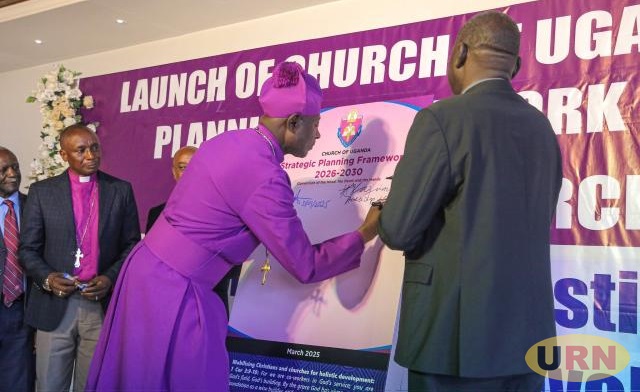Archbishop Stephen Kazimba Mugalu, the head of Church of Uganda (CoU), has signed the poster for the newly approved CoU Strategic Planning Framework for 2026-2030, introducing a groundbreaking shift in church practices to promote environmental conservation.
In a bold move to address climate change and environmental degradation, the Church has decided to abolish the tradition of laying wreaths on caskets during burials, opting instead to encourage the planting of trees as a symbolic and sustainable practice to honor the deceased.
The decision was made during a joint session of the Provincial Council and the House of Bishops, where the framework was approved.
Archbishop Kazimba explained that this initiative aims to increase awareness and adoption of environmentally friendly practices across the 39 dioceses of the CoU.
The framework is designed to guide the church’s response to the growing challenges posed by climate change and environmental destruction.
“The new strategic plan is a call to action for all dioceses to step up their efforts in environmental conservation and climate change adaptation,” Archbishop Kazimba stated.
He emphasized the need for church leaders to develop tailored preparedness and response strategies for environmental disasters in their respective communities.
A key feature of the framework is the decision to abolish wreaths at burials, with priests encouraged to replace this practice by planting trees instead.
This new tradition will be promoted across the CoU’s entire province. Additionally, the Church will focus on raising awareness about environmental protection through regular sermons, urging Christians to reduce the use of polythene bags and adopt eco-friendly habits.
Each diocese is tasked with forming an Environmental Protection Coordination Taskforce and appointing focal persons at both the diocese and parish levels.
The taskforces will be responsible for promoting the use of renewable energy and alternative cooking methods, reducing reliance on firewood, and ensuring that unused Church land is used for planting a mix of fruit trees and indigenous species to support food security and carbon sequestration.
At the launch of the framework, Archbishop Kazimba expressed hope that, if well-implemented, the plan would enable dioceses to adapt to the rapidly changing environmental landscape and address emerging challenges promptly.
He encouraged the bishops to collaborate with government ministries, civil society organizations, and church structures to ensure the strategic objectives are met.
To oversee the implementation of this comprehensive plan, a 24-member steering committee has been established. The Church has also developed a monitoring and evaluation system to assess the framework’s progress and impact across dioceses.
In addition to environmental efforts, the new framework also focuses on mission and evangelism, socio-economic development, institutional development, and community engagement building on the priorities established in the expiring 2016-2026 strategic plan.
